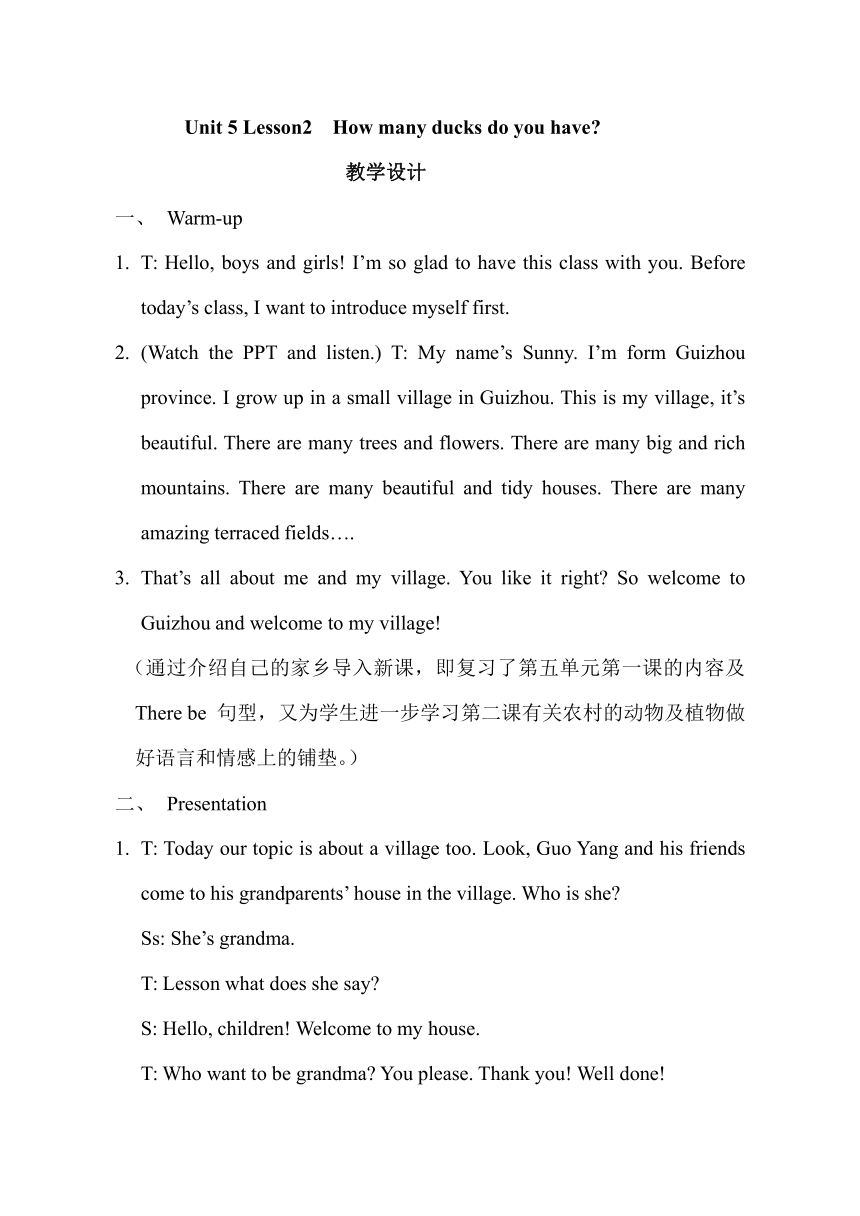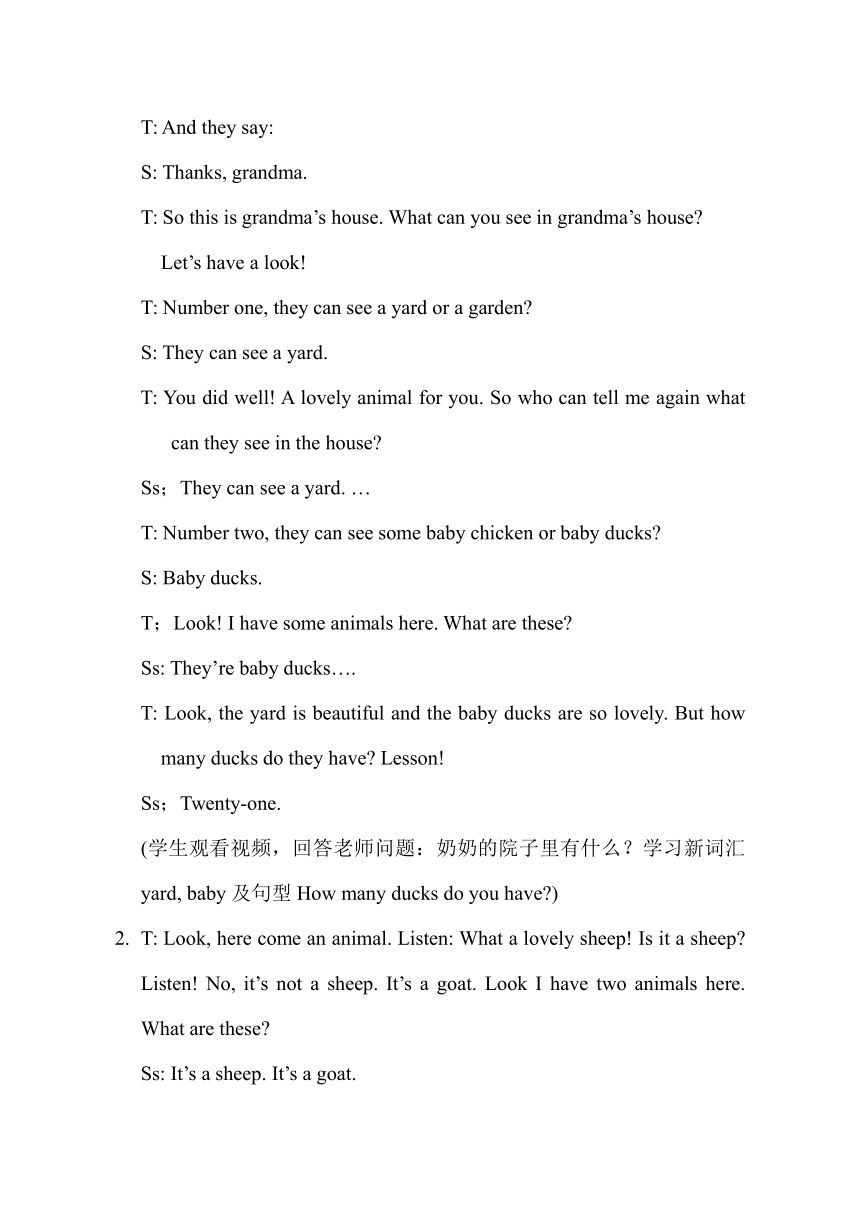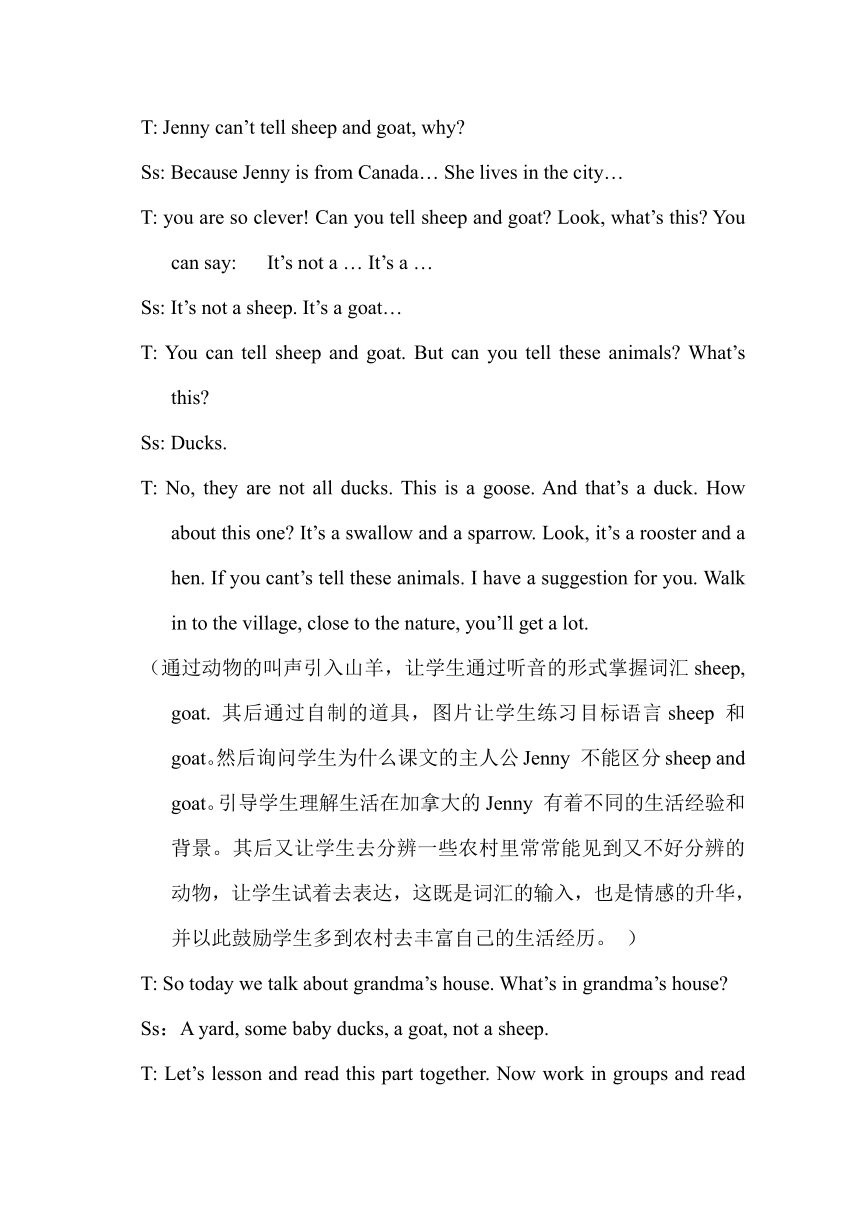Unit 5 Lesson 2 How many ducks do you have? 教案
文档属性
| 名称 | Unit 5 Lesson 2 How many ducks do you have? 教案 |  | |
| 格式 | doc | ||
| 文件大小 | 40.5KB | ||
| 资源类型 | 教案 | ||
| 版本资源 | 鲁科版(五四制) | ||
| 科目 | 英语 | ||
| 更新时间 | 2022-05-09 20:05:17 | ||
图片预览



文档简介
Unit 5 Lesson2 How many ducks do you have
教学设计
1、 Warm-up
1. T: Hello, boys and girls! I’m so glad to have this class with you. Before today’s class, I want to introduce myself first.
2. (Watch the PPT and listen.) T: My name’s Sunny. I’m form Guizhou province. I grow up in a small village in Guizhou. This is my village, it’s beautiful. There are many trees and flowers. There are many big and rich mountains. There are many beautiful and tidy houses. There are many amazing terraced fields….
3. That’s all about me and my village. You like it right So welcome to Guizhou and welcome to my village!
(通过介绍自己的家乡导入新课,即复习了第五单元第一课的内容及There be 句型,又为学生进一步学习第二课有关农村的动物及植物做好语言和情感上的铺垫。)
2、 Presentation
1. T: Today our topic is about a village too. Look, Guo Yang and his friends come to his grandparents’ house in the village. Who is she
Ss: She’s grandma.
T: Lesson what does she say
S: Hello, children! Welcome to my house.
T: Who want to be grandma You please. Thank you! Well done!
T: And they say:
S: Thanks, grandma.
T: So this is grandma’s house. What can you see in grandma’s house
Let’s have a look!
T: Number one, they can see a yard or a garden
S: They can see a yard.
T: You did well! A lovely animal for you. So who can tell me again what can they see in the house
Ss;They can see a yard. …
T: Number two, they can see some baby chicken or baby ducks
S: Baby ducks.
T;Look! I have some animals here. What are these
Ss: They’re baby ducks….
T: Look, the yard is beautiful and the baby ducks are so lovely. But how many ducks do they have Lesson!
Ss;Twenty-one.
(学生观看视频,回答老师问题:奶奶的院子里有什么?学习新词汇yard, baby及句型How many ducks do you have )
2. T: Look, here come an animal. Listen: What a lovely sheep! Is it a sheep Listen! No, it’s not a sheep. It’s a goat. Look I have two animals here. What are these
Ss: It’s a sheep. It’s a goat.
T: Jenny can’t tell sheep and goat, why
Ss: Because Jenny is from Canada… She lives in the city…
T: you are so clever! Can you tell sheep and goat Look, what’s this You can say: It’s not a … It’s a …
Ss: It’s not a sheep. It’s a goat…
T: You can tell sheep and goat. But can you tell these animals What’s this
Ss: Ducks.
T: No, they are not all ducks. This is a goose. And that’s a duck. How about this one It’s a swallow and a sparrow. Look, it’s a rooster and a hen. If you cant’s tell these animals. I have a suggestion for you. Walk in to the village, close to the nature, you’ll get a lot.
(通过动物的叫声引入山羊,让学生通过听音的形式掌握词汇sheep, goat. 其后通过自制的道具,图片让学生练习目标语言sheep 和goat。然后询问学生为什么课文的主人公Jenny 不能区分sheep and goat。引导学生理解生活在加拿大的Jenny 有着不同的生活经验和背景。其后又让学生去分辨一些农村里常常能见到又不好分辨的动物,让学生试着去表达,这既是词汇的输入,也是情感的升华,并以此鼓励学生多到农村去丰富自己的生活经历。 )
T: So today we talk about grandma’s house. What’s in grandma’s house
Ss:A yard, some baby ducks, a goat, not a sheep.
T: Let’s lesson and read this part together. Now work in groups and read it.
T: I like your pronunciation. Thank you!
3. T: Guo Yang comes to his grandparents’ house. They see grandma. But where is grandpa Lesson!
Ss: He’s in the vegetable garden.
T: What’s in grandpa’s vegetable garden Let’s have a look.
Ss: There are cucumbers, tomatoes and potato plants.
T: Look I have some cucumbers here. If you’re a cook, what can you cook
Ss: I can cook … and cucumbers…
T: So I have some cucumbers, tomatoes and potato plants. Where are the potatoes Listen!
Ss: They’re in the soil.
T: I have some vegetables here. I have peanuts, carrots and sweet potatoes. And I have some plants here. Can you guess they’re what plants, and what are in the soil
T: Are they peanut plants Are they carrot plants
Ss: Yes.
T: So we can say: They’re carrot plants. The carrots are in the soil.
Ss: They’re peanut plants. The peanuts are in the soil. They’re sweet potato plants. The sweet potatoes are in the soil. …
T: Look, how many potatoes do they have Let’s count.
Ss: One, two… seven. Seven potatoes.
(这一部分通过让学生观看视频回答问题的形式让学生掌握词汇cucumbers, plants及句型They’re in the soil. 其后我通过我是厨师,我会做…及认识菜园子里的蔬菜苗两个环节,给学生创设真实有趣的情景,让学生在喜欢的情景中练习目标语言,并拓展了学生的视野和词汇量。 )
3. T:In this part, we talk about grandpa’s vegetable garden. What’s in it
Ss: cucumbers, tomatoes and potato plants.
T: Where are the potatoes
Ss: They’re in the soil.
T: Now let’s listen and read together. Then read in groups.
3、 Production
T: Boys and girls, can you design your yard or vegetable garden Now let’s do it with your partners. Then talk about it with us. You can stick or draw on your paper.
Ss: Welcome to my yard. It’s beautiful!
How many sheep do you have …
( 通过设计自己的后院或菜园环节,让学生在课堂的最后进行语言的输出,提高学生的语言运用能力。)
4、 Extending
Today we have a look at my village, Guo Yang’s grandparents’ village and your village. You know there are many beautiful villages in western countries. Now we have a look at the village in Belgium. And tell me what’s in this beautiful village
Ss: Some trees and flowers, some ducks…
教学设计
1、 Warm-up
1. T: Hello, boys and girls! I’m so glad to have this class with you. Before today’s class, I want to introduce myself first.
2. (Watch the PPT and listen.) T: My name’s Sunny. I’m form Guizhou province. I grow up in a small village in Guizhou. This is my village, it’s beautiful. There are many trees and flowers. There are many big and rich mountains. There are many beautiful and tidy houses. There are many amazing terraced fields….
3. That’s all about me and my village. You like it right So welcome to Guizhou and welcome to my village!
(通过介绍自己的家乡导入新课,即复习了第五单元第一课的内容及There be 句型,又为学生进一步学习第二课有关农村的动物及植物做好语言和情感上的铺垫。)
2、 Presentation
1. T: Today our topic is about a village too. Look, Guo Yang and his friends come to his grandparents’ house in the village. Who is she
Ss: She’s grandma.
T: Lesson what does she say
S: Hello, children! Welcome to my house.
T: Who want to be grandma You please. Thank you! Well done!
T: And they say:
S: Thanks, grandma.
T: So this is grandma’s house. What can you see in grandma’s house
Let’s have a look!
T: Number one, they can see a yard or a garden
S: They can see a yard.
T: You did well! A lovely animal for you. So who can tell me again what can they see in the house
Ss;They can see a yard. …
T: Number two, they can see some baby chicken or baby ducks
S: Baby ducks.
T;Look! I have some animals here. What are these
Ss: They’re baby ducks….
T: Look, the yard is beautiful and the baby ducks are so lovely. But how many ducks do they have Lesson!
Ss;Twenty-one.
(学生观看视频,回答老师问题:奶奶的院子里有什么?学习新词汇yard, baby及句型How many ducks do you have )
2. T: Look, here come an animal. Listen: What a lovely sheep! Is it a sheep Listen! No, it’s not a sheep. It’s a goat. Look I have two animals here. What are these
Ss: It’s a sheep. It’s a goat.
T: Jenny can’t tell sheep and goat, why
Ss: Because Jenny is from Canada… She lives in the city…
T: you are so clever! Can you tell sheep and goat Look, what’s this You can say: It’s not a … It’s a …
Ss: It’s not a sheep. It’s a goat…
T: You can tell sheep and goat. But can you tell these animals What’s this
Ss: Ducks.
T: No, they are not all ducks. This is a goose. And that’s a duck. How about this one It’s a swallow and a sparrow. Look, it’s a rooster and a hen. If you cant’s tell these animals. I have a suggestion for you. Walk in to the village, close to the nature, you’ll get a lot.
(通过动物的叫声引入山羊,让学生通过听音的形式掌握词汇sheep, goat. 其后通过自制的道具,图片让学生练习目标语言sheep 和goat。然后询问学生为什么课文的主人公Jenny 不能区分sheep and goat。引导学生理解生活在加拿大的Jenny 有着不同的生活经验和背景。其后又让学生去分辨一些农村里常常能见到又不好分辨的动物,让学生试着去表达,这既是词汇的输入,也是情感的升华,并以此鼓励学生多到农村去丰富自己的生活经历。 )
T: So today we talk about grandma’s house. What’s in grandma’s house
Ss:A yard, some baby ducks, a goat, not a sheep.
T: Let’s lesson and read this part together. Now work in groups and read it.
T: I like your pronunciation. Thank you!
3. T: Guo Yang comes to his grandparents’ house. They see grandma. But where is grandpa Lesson!
Ss: He’s in the vegetable garden.
T: What’s in grandpa’s vegetable garden Let’s have a look.
Ss: There are cucumbers, tomatoes and potato plants.
T: Look I have some cucumbers here. If you’re a cook, what can you cook
Ss: I can cook … and cucumbers…
T: So I have some cucumbers, tomatoes and potato plants. Where are the potatoes Listen!
Ss: They’re in the soil.
T: I have some vegetables here. I have peanuts, carrots and sweet potatoes. And I have some plants here. Can you guess they’re what plants, and what are in the soil
T: Are they peanut plants Are they carrot plants
Ss: Yes.
T: So we can say: They’re carrot plants. The carrots are in the soil.
Ss: They’re peanut plants. The peanuts are in the soil. They’re sweet potato plants. The sweet potatoes are in the soil. …
T: Look, how many potatoes do they have Let’s count.
Ss: One, two… seven. Seven potatoes.
(这一部分通过让学生观看视频回答问题的形式让学生掌握词汇cucumbers, plants及句型They’re in the soil. 其后我通过我是厨师,我会做…及认识菜园子里的蔬菜苗两个环节,给学生创设真实有趣的情景,让学生在喜欢的情景中练习目标语言,并拓展了学生的视野和词汇量。 )
3. T:In this part, we talk about grandpa’s vegetable garden. What’s in it
Ss: cucumbers, tomatoes and potato plants.
T: Where are the potatoes
Ss: They’re in the soil.
T: Now let’s listen and read together. Then read in groups.
3、 Production
T: Boys and girls, can you design your yard or vegetable garden Now let’s do it with your partners. Then talk about it with us. You can stick or draw on your paper.
Ss: Welcome to my yard. It’s beautiful!
How many sheep do you have …
( 通过设计自己的后院或菜园环节,让学生在课堂的最后进行语言的输出,提高学生的语言运用能力。)
4、 Extending
Today we have a look at my village, Guo Yang’s grandparents’ village and your village. You know there are many beautiful villages in western countries. Now we have a look at the village in Belgium. And tell me what’s in this beautiful village
Ss: Some trees and flowers, some ducks…
同课章节目录
- Unit 1 Winter Holidays
- Lesson 1 What did you do in the holidays?
- Lesson 2 I didn’t ski.
- Lesson 3 Everyone was happy that day.
- Lesson 4 Again ,please!
- Unit 2 Good Behaviou
- Lesson 1 Let’s stop and wait
- Lesson 2 Don’t shout,please.
- Lesson 3They are in the zoo.
- Lesson 4 Again ,please!
- Unit 3 Health
- Lesson 1 What’s wrong with you?
- Lesson 2 How are you feeling today?
- Lesson 3 How can we keep healthy?
- Lesson 4 Again ,please!
- Unit4 Neighbourhood
- Lesson 1 He lives next to me.
- Lesson 2 Is there a gym around?
- Lesson 3 They are having lots of fun.
- Lesson 4 Again ,please!
- Unit 5 Country Life
- Lesson 1 There is a river near the village.
- Lesson 2 How many ducks do you have?
- Lesson 3 He goes to school by school bus.
- Lesson 4 Again ,please!
- Unit 6 Plan for the Summe
- Lesson 1 What are you going to do this summer holi
- Lesson 2 You’d better take an umbrella.
- Lesson 3 Get ready for a new school life!
- Lesson 4 Again ,please!
